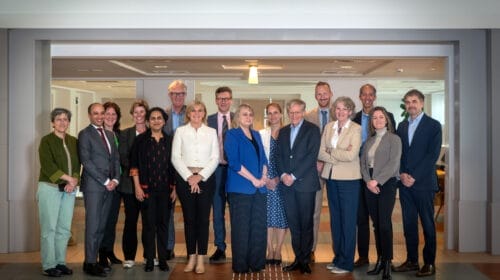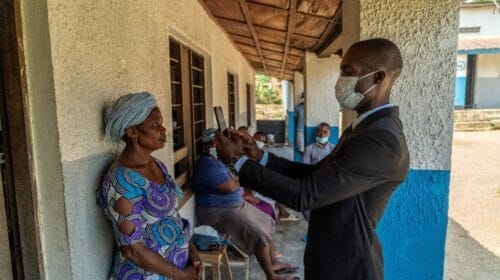Samora Pinderhughes Explored Incarceration in Song. The Result Is ‘Grief.’

OAKLAND, Calif. — Near the end of a sold-out show earlier this month, celebrating the release of his visionary second album, “Grief,” the vocalist, pianist, composer and activist Samora Pinderhughes asked the audience to sing with him. He was about to hit the coda to “Process” — a heart-baring anthem of solitude and self-forgiveness, which he uses to close all his concerts — and he wanted some familiar voices to join the wordless melody.
For every new fan who’d showed up that night at the downtown headquarters of the online music store Bandcamp, a member of Pinderhughes’s close-knit community seemed to be there too. Standing in the back was his friend Adamu Chan, a filmmaker and organizer, who had been incarcerated early in the pandemic and is now working on a documentary about Covid-19’s spread in the prison system. In the front row, an arm’s length from the grand piano, sat one of his mentors, the historian Robin D.G. Kelley. A few seats down were Pinderhughes’s parents, scholars and activists themselves.
In the past few years Pinderhughes, 30, has been breaking out well beyond the Bay Area, and with the release of “Grief,” he’s emerged as one of the most affecting singer-songwriters today, in any genre. His trebly, confessional voice steps deliberately on its own cracks, and he treats his gut-level lyrics with care. His piano playing, rich with layered harmony and rhythmic undertow, holds together his arrangements, which mix the influences of Radiohead, chamber classical, Afro-Cuban rhythms and underground hip-hop. Not unlike Kendrick Lamar, Pinderhughes has become a virtuoso at turning the experience of living in community inside-out, revealing all its personal detail and tension, and giving voice to registers of pain that are commonly shared but not often articulated.
The “Grief” LP is one of three components in the Healing Project, a yearslong undertaking based around roughly 100 interviews Pinderhughes conducted with people of color who had been incarcerated or had experienced some form of “structural violence,” he said. The first part of the project was a visual-art exhibition that opened at the Yerba Buena Center for the Arts in San Francisco in March, and will be on view through September. Then came “Grief” last month. And on Tuesday, he unveiled an online archive of the interviews and an accompanying interactive online experience, which he hopes will help to bring listeners from all over the country — and beyond — into contact with the stories of his interviewees and their arguments for prison abolition.
Pinderhughes created the Healing Project in pursuit of answers to two lines of inquiry, both about mass incarceration in the United States. “How is this operating, and what is the machinery that’s going on systemically that’s doing this to us, and how can we fight back? That’s one set of questions,” he said over coffee in Harlem, where he now lives. “And then the other one, on the personal tip, is: How am I a part of that? How am I implicated and how am I doing something against it? What does that make me feel like? How am I dealing?”
Pinderhughes is currently on his way to a Ph.D. in creative practice and critical inquiry from Harvard, where he studies under the pianist and scholar Vijay Iyer, who called him an “unstoppable creative force.”
Coping With Grief and Loss
Living through the loss of a loved one is a universal experience. But the ways in which we experience and deal with the pain can largely differ.
“He’s just constantly making new things: new music, new writing. Imagining past the standard contours of the music business, even,” Iyer said. “That’s been the most exciting thing to witness — that, through a lot of study and surveying the landscape, and doing a lot of community work and just being in the trenches, he’s sort of imagining another way to be a musician.”
A SLIGHT MAN with a flop of brown hair dumped over alert eyes, Pinderhughes is fashion-forward but understated, favoring denim gear and streetwear. When we walked the San Francisco exhibition earlier this month, he was dressed in a burnt-orange jean jacket and a faded tee from Daily Paper, a Black-owned brand based in Amsterdam. In conversation he’s quick to laugh, and always on the lookout for points of common ground.
“He is cool, because he’s in the jazz world, but he’s not cool in that way of cutting himself off from feeling,” said the actress and playwright Anna Deavere Smith, who is one of Pinderhughes’s mentors and a producer of the Healing Project. (Iyer and the artist Glenn Ligon are the others.)
Pinderhughes, who is of Black and mixed-race ancestry, was raised in Berkeley, Calif., by professor parents who work in urban and environmental planning (his mother, Raquel Rivera-Pinderhughes), and at the intersection of race, behavioral science and violence prevention (his father, Howard Pinderhughes). Both are active community organizers, and their connection to incarcerated populations around the country helped Pinderhughes get the Healing Project off the ground.
Music was constantly around the house, which was littered with hand drums and other small instruments, though only the children played. Both Samora and his sister, Elena, a flutist who has become a major player in jazz, showed promise early. He began playing percussion almost as soon as he could land his hand on the drum, and his parents started taking him to La Peña Cultural Center in Berkeley, where he was immersed in Cuban and Venezuelan music from age 3. When he was 10, his parents went to Cuba on sabbatical, and instead of enrolling in school he spent his time becoming ordained in the spiritual (and musical) tradition of Santería.
As a teenager, Pinderhughes attended the Young Musicians Program (now the Young Musicians Choral Orchestra) in Berkeley, which caters to low-income students and has produced many of the current jazz generation’s brightest stars. “The spaces where I learned growing up, and where my sister learned, they were community spaces that combined the musical with the communal,” he said.
When he got to Juilliard, although he loved his piano teachers, Kendall Briggs and Kenny Barron, alienation set in fast. “As an institution, it totally felt like a factory,” Pinderhughes said. “We’re here to get as good as we can at playing the music, but we don’t talk about why we’re doing what we’re doing. I don’t know if I had three conversations about that.”
He pushed through, graduating in 2013 and settling in to create a major work of protest, “The Transformations Suite.” Close to an hour of semi-orchestral jazz, laced with poetic broadsides against the establishment, the 2016 album was proof-positive of Pinderhughes’s vision and his rigor. It caught the attention of Common, Karriem Riggins and Robert Glasper, who invited him to tour and record with their August Greene project.
Keith LaMar, an author and activist on death row in Ohio, was also impressed by “The Transformations Suite,” and through friends he got in touch with Pinderhughes. The musician joined a group of artists working to raise awareness about LaMar’s case, and LaMar became part of the Healing Project. “He’s talking about speaking truth to power, he’s talking about your agency, putting it in perspective, the unequal distribution of wealth and how it’s basically the foundation of all the inequalities that exist in this country,” LaMar said in an interview.
“The Transformations Suite” had been forceful as a manifesto of rightful outrage, but it wasn’t really a document of intimacy. For his next project, Pinderhughes started to interview men and women impacted by the criminal justice system, hearing their stories up close.
ON ‘GRIEF,’ PINDERHUGHES focuses on an emotion that we all intimately know and fear, but that comes in particularly high frequency close to prisons and incarceration. He said that Nina Simone and Curtis Mayfield had been his lodestars: “To me, those are both artists that are working out ideas about how to contextualize not just their life, but their own entire communities’ lived situation.”
Pinderhughes recorded the album — which was co-produced by his longtime collaborator Jack DeBoe — in pieces during the pandemic, overdubbing one instrumental section at a time to help maintain social distancing in the studio. Some tracks have only a string quartet, playing slowly dragged harmonies that sometimes pinch into fine-grain dissonance. Others have a full band, with Pinderhughes often playing the Rhodes, sputtering beats underneath and gossamer strings above.
On “Holding Cell,” a highlight, voices harmonize over swarming violins, cello and electric bass; the harmony shifts tensely around them as they sing: “Holding cell/I can’t get well while you hold me.” For the title track, one of the most patiently beautiful songs — co-written with the bassist Burniss Earl Travis, known as Boom Bishop — two chords are all Pinderhughes and the band need to build a sonic whirlpool, conjuring the disorientation of loss.
A standout of the Healing Project exhibition at the Yerba Buena center is the one piece without any visuals: a small, darkened room with a bench surrounded by speakers. They play an hour-and-a-half-long audio piece on loop, lining up clips from Pinderhughes’s interviews over ambient, sometimes ominous backing tracks that he recorded. The way they’re edited, these voices present critiques and reflections from within the system, not simple narratives of personal trauma or triumph over the odds.
“With the sound room, you’re in the middle of the sound, and there’s nothing but you and the voices,” Pinderhughes said. “What I wanted to create is: ‘This is your brain.’ There is no us-and-them.” Everything is first person, he explained, “So unless you’re doing the work of separating yourself from the experiences, you’re in it.” (In this way, he acknowledged, he had been inspired by a conversation he’d seen on YouTube between the author bell hooks and the artist Arthur Jafa. In it, Jafa says that any camera can effectively function as a tool of the white gaze.)
The people whose voices Pinderhughes uses in the sound room share publishing rights to the tracks that feature them, something that Pinderhughes saw as nonoptional. Some also have bio pages on the Yerba Buena center’s Healing Project website.
In one clip, Keith LaMar speaks about feeling victorious simply for having maintained his “sweetness” — a personal quality that’s obvious in his voice — despite the inhumanities of living in solitary confinement for decades. He calls the prison system a “digestive tract,” not a space of rehabilitation.
Not long after comes the voice of Roosevelt Arrington, an educator and peer mentor who spent years in the system. He says that socially accepted language can be dehumanizing: “‘Inmate,’ ‘convict,’ ‘ex-felon,’ they’re demeaning titles: They’re put in place to diminish self-respect and dignity, and to demean you and to break your spirit.” He adds, “When a person feels like they have no self-value and no self-worth, that mind-set tends to take them back to a criminal element.”
The exhibition also includes visual artworks by Pinderhughes himself; the artist Titus Kaphar, who also designed the “Grief” LP cover; Nnaemeka Ekwelum, whose works in the gallery are a variation on Nigerian funeral cloths; and Peter Mukuria, known as Pitt Panther, who’s currently incarcerated in Virginia and serves as the minister of labor for the Revolutionary Intercommunal Black Panther Party.
Since connecting for the Healing Project, Mukuria and Pinderhughes have become close, and now talk by phone multiple times a week. In the gallery hang a number of works Mukuria drew on prison bedsheets, including a portrait of George Floyd, a piece to accompany the song “Process,” and a strikingly intimate scene with Mukuria seated in his cell. The show also has an altar, drawing from Afro-Latino traditions and New York City street culture, with a faceless portrait at its center, inviting visitors to honor anyone they’ve lost.
Pinderhughes plans to take the Healing Project around the country, ideally reaching all the 15 states where he did interviews. He hopes it can ultimately become a permanent installation somewhere, someday. “I want to build a space that actually engages, and is able to offer the healing practices that I’ve learned through the interviews,” he said. “In an everyday context, offer those things.”




